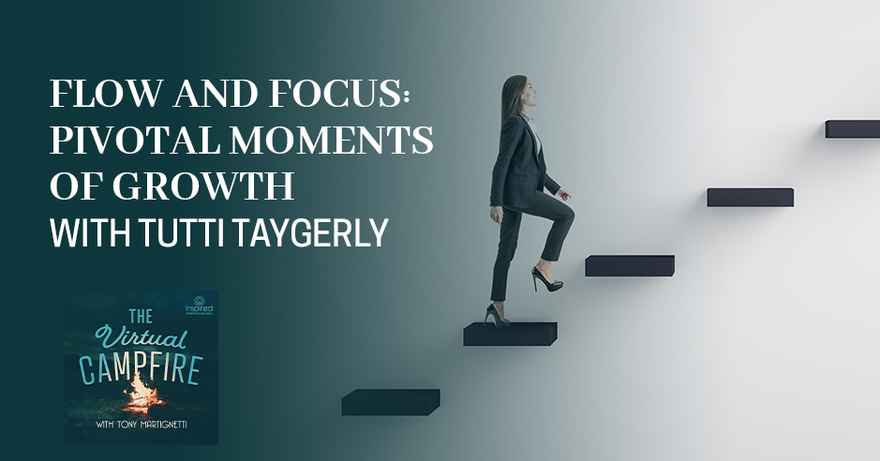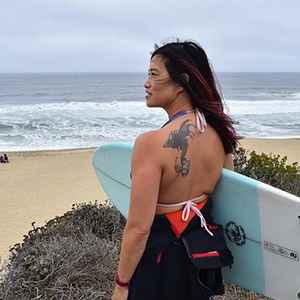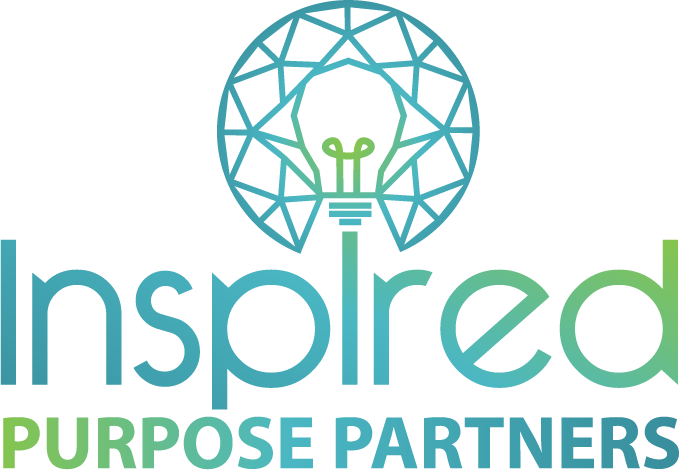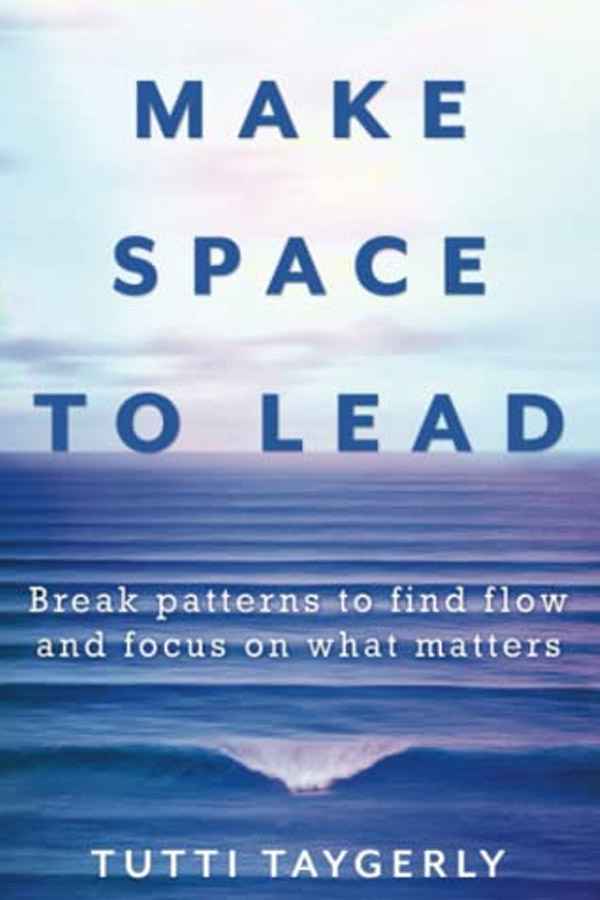Flow And Focus: Pivotal Moments Of Growth With Tutti Taygerly

When everything seems perfect, life throws you a curveball that makes you assess where you’re at and where you want to be. And sometimes, it's at our lowest time that we find our true passion and purpose. In this episode, leadership and executive coach Tutti Taygerly tells us a story of personal flashpoints and how those pivotal moments brought personal growth and influenced growth in others as she realized her passion for people, processes, culture, and personal transformation. She talks about the importance of feedback and coaching and how creativity plays into her coaching module. Tutti then shares how visualizing your future can pave the way to finding the best version of yourself. So if you feel like you cannot sink any deeper, listen in and learn how to break through with focus and flow. After all, when you’re down, there is nowhere else to go but up.
---
Listen to the podcast here
Flow And Focus: Pivotal Moments Of Growth With Tutti Taygerly
It is my honor to introduce you to my guest, Tutti Taygerly. She coaches cofounders and tech leaders to embrace their unique leadership styles to achieve professional impact and sustainable company cultures. She was a design leader at design firms, startups, and large companies, including Disney and Facebook. She writes for Harvard Business Review, Business Insider, and Fast Company. In her book, Make Space to Lead, which is fantastic. She shows high achievers how to reframe our relationships to work. She lives in California and is most in her element when she's out surfing. It is truly an honor and a pleasure to welcome you to the show.
I'm happy to be here. I'm warming up my hands in the fire.
I know you love campfires. You are always out in nature and having fun. This is the right place for us to be. I'm thrilled to have you on. I'm looking forward to unpacking your journey to making such a big impact in the world. What we are going to do on the show is we are going to talk about these flashpoints, these points in your journey that have ignited your gifts into the world. As you are sharing, we will stop along the way and see what's showing up. With that, I'm going to turn it over to you and share what you are called to share.
One of my major flashpoints was this space between my 1st and 2nd career. As you mentioned in the bio, I had a 22-year career as a design leader in tech. In a lot of ways, it was very conventional. I had an Asian tiger mom who pushed me. She’s a valedictorian and got into the best schools, worked into the best jobs, and climbed that career ladder.
I did that for a long time with this perfect little life. Great job ascending that career level, a house, kids, husband, and all of those aspects. What was interesting is that I would say that I did love what I do. I love designing, problem-solving, and being very creative in figuring out what the next iteration of Facebook video is going to be or how to dream up futures for the world's top brands.
My flashpoint midlife crisis, if you will, I had a pretty hell year where all of this cracked and fell apart with my father-in-law passing, and I had known him since I was eighteen. I ended up getting divorced from my husband, my kid's dad, and I had two young kids. At the tail end of that same year, my own father passed.
It was everything all at once. It was one of the hardest periods of my life, and through that type of experience comes growth in space. I was able to slow down, make space, and figure out what is it that I wanted to be doing with my time. How much time did I want to be devoted to working? I worked 60 to 80-hour work weeks and had a daily three-hour commute down to Menlo Park.
Through the toughest experience comes growth.
It was with that knowledge and insight that I decided to leave the corporate world and start diving deeper into coaching because I found that I loved people management and mentorship. I had been doing some coaching while at Facebook on the side. My 10% job is separate from the main products that I support. It was a reemergence where I was like, “I'm going to leave my job. I'm going to start learning and training more about this because I care so much about the people’s processes, culture, and personal transformation.” It was my own journey into a second career exploring in the aftermath of a hell year. That was my flashpoint.
It is a hell year. That's exactly how I would describe it. Handling all of those things all at once is a lot to go through but it does have you create this sense of like, “What do I want? What do I want to experience in life? I have one question about this. You said that you were doing some coaching before you left the corporate world. What got you started on that path? Was it something that you were offered, and then you started to connect to it? Sometimes people don't even know coaching is available or even it exists. What got you started on that path?
I got my first executive coach several years ago. Now when I work with leaders, I work with a lot of women, people of color, and immigrants. People who often feel like they are the other, that they don't necessarily belong, and maybe strive to lead in a certain way. That context matters because when I got my first coach, I was the only woman and the only person of color in the C-Suite. It’s the C-Suite of a consulting company.
My boss, the CEO, gave me some feedback. I won't put any judgment on it. He gave me some feedback, and the feedback was along these lines. It was, “You are great. You are passionate and visionary. All the women in the firm look up to you, and you are aggressive. There's a lot going on here. You can be difficult to work with.”
I was like, “I have never heard this feedback.” Now with hindsight and a better understanding of unconscious bias and the systems that we live in, there are two truths there. One, there was unconscious bias going on around how a woman is perceived and how a person of color, especially an Asian woman who, may fit more stereotypes of, “Maybe should be a little bit quieter or more respectful diminutive.”
The likability bias of a woman versus a man. Now, I know those, then I didn't. That's true. The second thing that's also true, and this is the part that hit my gut level, is how the way that I'm showing up, it works well with some people. People who are direct and have a certain type of communication style but I'm inadvertently shutting down a lot of other people. I don't mean to. There's no intention to but with the amount of space that I'm taking up with this creativity, passion, and personality, I'm sucking the air out of the room for people who are different types of communicators.
It’s about practicing this range, and I feel that my first experience with a coach was transformative because it helped me get to this insight. It helped me get through the self-critics of, “What's wrong with me? I can't hang with this group of people because I'm different. I don't belong.” It helps get it more actionable and forward-looking to be like, “I can still lead as an Asian woman. I can still exist and figure out how to practice range within this overall system.” That was my very first coach. Since then, I have had tens of coaches. Probably 4 or 5 coaches in was when I worked at Facebook, and I was tapped to be part of a leadership program of women’s support. There were 9 of us supported by 4 coaches.

It was a wonderful program. We worked. We talked a lot about how to show up and lead like a woman. How to deal with Imposter syndrome and many deep topics. It was a pilot program. Facebook wanted to expand it. They had the instructors train us. Women who had gone through the program started giving and helping facilitate the program. That was a little bit of where I started practicing some of these skills, not formally trained but a little bit of overlap between reading, leadership, and mentorship. Two different stories about what got me into coaching.
There's something about what you said about the keyword that I latch onto, which is the range and harnessing the power of your range that comes from that awareness of your range and how to use it. If you don't know that and how that range can be used, then it doesn't become useful.
Also, the two parts of it. The range comes from you and your capacity to play on a spectrum but it also comes from the experience of the recipient. The people on the other side, whether it's a single person or a group, which is how you are perceived.
Starting a company in coaching is a whole other animal because then you have this sense of, “Great. I understand these skills but how do I create a business around it?” That's something that is not for the faint of heart.
One of the things that have been a value that has been with me my entire life is personal transformation and personal growth. I have also had a stereotype of being a good girl. I like my guides. I like being told what to do. I like to learn. There's also a rebellion in there, and I put those together. What was important when I was starting my own company was to learn and train in two parts. One, understand the skill and craft of being a coach, and that's completely different from being a tech operator. As a tech operator, you are problem-solving. You are offering solutions. You are being the expert in guiding the team.
As a coach, you are holding space. Getting the other person or the group of people to their own solutions. You are not meant to be the smartest person in the room to offer up these solutions. It took me many months and years to learn that and also to learn how to switch hats between different things.
When I started my own company, I had one arm of learning, which was my coach training, and I got certified through the Co-Active Training Institute. On the other side, I'm like, “I have done business development for companies before. It's different to do it on behalf of me and the thing that I'm creating.” I went and studied and got a coach to do it. I walked the walk, which is working with a guy we both know, Rich Litvin, who wrote The Prosperous Coach. Hand in hand, I was learning the craft of what I was doing coaching as well as learning the business behind it. It was a lovely experimentation period to play with both sets of skills at the same time.
You're not meant to be the farthest person in the room to offer solutions.
There's something about this, which is to say we don't have all the answers and must be able to explore different experts in the field and ways of learning from others. That becomes an avenue for us to build our foundation. One of the things that I often hear from guests is the sense like, “You don't do it alone.” Even as you get into your own business, it's not that the business is, “I did it all on my own.” There are usually people along the way who help you. Tell me about that.
That's one of the biggest things because I coach a lot of people startup cofounders, as well as people who are leaving the corporate world to start their own, whether it's so entrepreneur or something bigger. There can always be a sharp disconnect between the corporate world and you have a team. You have your identity of working for this company. There's a lot of identity in there for higher achievers, and what does it mean to be creating and carving out a new identity in something different?
There's figuring out that values and that brand but then it's also who are the people that you surround yourself with. What are the traits that you want there? How do you partner and collaborate with different people, and how do you build your community and your tribe of these people? Without that, one of the biggest mistakes is doing it alone, soldiering on alone, not wanting to ask for help, and wanting to appear very competent and capable. It's a harder path, and it takes a lot longer.
I want to take a moment to go a little further back so we can move forward. I want to understand the creative side of who you are. When you were a child, were you a creative child?
I was a very imaginative child. I made up a lot of stories. I wrote a lot, which is ironic because I went away from writing for many years until I started publishing my first book. I'm working on a second now. I would create new worlds. I used lots of play mobile with scenes and stories. Through play and writing was where a lot of creativity was imagined.
The reason why I've asked that is that I feel the sense of when you are a child, some of us are creative, and then we have this stuffing that down for a while and then come back to it later in life. Especially in the coaching and the work you are doing now, I can sense that there's a lot of creativity that comes into the work you are doing now. Not just the writing but also in working with people. Talk to me about how creativity shows up beyond the writing part in your coaching.
I was lucky enough to have a career as a designer where my job was creating and making. For the most part, it was in products. It’s imagining, dreaming, and conceptualizing the experience of someone with a digital product, whether it's a big data set and being able to clean it up or whether it's with how to watch and connect people over video. Their creativity and creating have always been a part of my life.

What is wonderful is that I talk to people and say, “I coach like a designer.” What I do is together, we start to envision who the future most fulfilled you is going to be, both professionally and personally. It could be 1, 3 or 5 years out. It could even be a couple of months out. We build that up in imagination. We make it feel real, then we figure out what's the path to get from here to there. It's not a straight path. It's a series of experiments and iterations, and we are going to play with them together. It's pretty similar to how I made products for many years but it's envisioning the best and most worthwhile in people's leadership.
I love that. There's a sense of connection to that imagination and creativity. There are some aspects of design that are also principled in structure, logic, and making sure that you follow a path. You got to marry both sides of the brain into this thinking, which is why a lot of people connect with this path of going and having a coach because it helps them to stay on track to achieve a goal but first by setting a goal and that requires some sense of dreaming.
It's the balance between the two of them. Sometimes I call it force and flow. Force being the structure or the rigor being, “We are going to work on something little every single day,” and then the flow being, “How do you follow the energy? How do you get into this state where it is playful, fun, and not too rigid?” We all make mistakes.
We get into this mode where we are like, “I want this goal, and I'm going to work and work too hard about it.” Being aware of where you are on that force versus flow and knowing what your patterns are. I tend to have a pattern of being too forceful and structured because I can have control or saboteur to want things in a certain way. It's also channeling that imaginative, creative side to get more into the flow. For many people, it's recognizing what your normal patterns and habits are and then experimenting with breaking or shifting them a little to change on that spectrum of force or flow.
I like that force or flow and understanding where you are getting yourself stuck. It's funny how you mentioned this because I feel there's a sense of flow that comes with surfing. We mentioned at the beginning about surfing. I'm often thinking about how when we are navigating through a path of trying to make sense of our world, we are trying to find that right way that's going to create that flow, the magic wave. Tell me how you think about surfing and how it relates to your business.
I’m going to hit on this on two levels and try and do it quickly. My first book is called Make Space to Lead, which uses the design process and this notion of flow to become more spacious. To get more into the being, the emotions, the relationships, and less like the, “how do I get down my to-do list to achieve these goals as quickly as possible?” One of the acronyms that I leave people with at the end is the SURF acronym. The F is what we were talking about, which is Force or Flow.
The SUR part is S is Stop for a minute. Recognize your pattern, be aware, and take a bit of a pause, so stop. U is Understand. Seek to be like, “What's happening here? What is this pattern? Why has it been happening before?” I hate snazzy acronyms but this was an editor thing. The R is a choose your own adventure of Rethink, Reimagine or Rebel. Choose a different path to redo things that have happened before. The F that we have talked about is what is this force versus flow? Where do you want to be on force versus flow? That was the more teachy coachy part of it.
It's time to do something different, to share and create more. It's time to inspire other people.
The more spiritual part of it is that surfing, for me, throughout my life, has been the only activity where I have been able to pretty much let go of a goal or an aim. It's such a unique experience. Most people think of surfing because these are the videos and clips we see of someone up riding a wave, going down in turn or maybe doing an aerial.
The proportion might be different for other people but the reality for me is if I'm out for a 2-hour surfing session, there might be 3 minutes of it. Maybe two minutes of it where I'm up and riding the wave. That is the proportion. Most of the time, you are sitting there on your board, you are scanning the horizon, you are looking for the sets and watching and waiting patiently because there's always another wave. There's always another set.
There's a lot of repetition in it around paddling. It's a lot of swimming, paddling, and getting yourself in the right position. Putting in the time, the work, and the hours. What I love about it is this perfect mixture of force and flow. There is a flow of paddling. There is a flow of sitting there waiting. There's a flow of being up in the wave but there's also a lot of patience being in the ocean. Being completely tumbled, mixed, and swirled around. It's a lot of metaphors for leadership in life.
There's a sense of also how people only see the end result of the person riding the wave. They don't see all the effort that goes into getting on that wave, which is also part of this thing that you can't judge things by the picture you see of the person riding the wave.
It looks perfect. That's what my entire life has been like. Come on. Isn't yours like this, Tony?
Of course. I love it. There's something you shared. There are so many good lessons from that, and it's a beautiful metaphor.
It's the thing that enlivens me the most and gives me the most energy and creativity to do the work I do.

We have touched on a lot of different things but I want to ask, are there any other flashpoints that you would love to share that you can go back in time or forward in time, or things that you are experiencing that you feel have a growth edge that you are on?
I have a big one and a big flashpoint. In terms of vulnerability, I'm still neck deep in it and haven't processed it fully. It's probably going to sound a little bit rawer. One of the flashpoints goes back to March or April of 2021. I experienced my first panic attack. It was on the slopes in Kirkwood. I'm a snowboarder as well. I had been willfully ignoring a lot of media.
Someone had texted me or something came up where I was confronting two big events that I had known of peripherally but had been ignoring. The first was the Atlanta spa shootings, where I believe six women of Asian descent were murdered in a spa by a person who claimed that Asian women may have been too tempting for that perspective. 6 of the 8 victims were Asian women. The second thing which I had also been suppressing and not thinking about is that there has been an uptick in anti-Asian incidents of violence.
In particular, in San Francisco, there was a Thai man who was my father's age who was murdered on the streets, and I had not been thinking about this. I knew they were there but didn't want to think about it. On that particular day, I was reading an article by RO Kwon. I don't remember the name of it. She's a great Asian-American writer but was writing the article about the heartache of being an Asian-American woman.
With that in the background, it was juxtaposed against a beautiful powdery day on the slopes, and I had my panic attack. Essentially, going up the chairlift and also being buried when I made a mistake and fell almost chest deep in white snow powder. There was something about that moment, the sheer physical exhaustion. The whiteness of the snow all around me where I was like, “I need to write about this. I need to talk about this.”
I have spent many years as an ardent feminist but have never been an advocate of my race. In Silicon Valley, Asian-Americans in many companies are almost part of the majority. Close to maybe 50% representation, so I had never thought about that. I thought about my minority of being a woman, which is maybe closer to 20% to 30% representation. That was a real flashpoint for me, and I also realized that the clients I serve were primarily women, people of color, and immigrants. That inspired this giant research project that turned into a book that I'm writing called Hardworking Rebels: How to Lead and Succeed as Asian-American Women.
What a blessing. Obviously, it comes from pain but it's a blessing that is what you are creating. I often think about this how it's hard to deal with the harsh reality of the fact that there's beauty in this world but it lives right next to so much ugliness and turmoil. I often think about that in some of the places I have been in the world.
Make space to slow down.
I always think of India and how the paradox is of absolute opulence next to absolute poverty, and they literally are right next door. Constantly, we are faced with those juxtapositions in the world, and it's hard because we want to believe in the best of everyone. Things like that happen, and then you realize how unsafe the world can be but you can do 1 of 2 things. You can either coil in and retreat or fight back in a positive way. That's the thing. It sounds like you are chosen the path of being a positive force, which is nice.
Many of us recoil, suppress, and push it down because these are safety and survival mechanisms for many years. Tying back to that story of how I got the feedback that first inspired me to get my first coach. There are coping mechanisms, and there's armor. There are all these strategies and patterns that we take inhabit because that's what we have to do to survive in the workplace and lead.
To make sense of the world around us.
These flashpoints, there are going to be moments in time where it's like, “I can't be like that anymore. I wish I could. It would be much easier and more comfortable but it's time to do something different. It's time to share and create more. It's time to inspire other people.”
It's fantastic what you are sharing, and great that the time is now for people to do something and anything that inspires people around them. I want to shift gears a little bit and ask a different type of question. You've shared a lot but I want to know, what are some lessons that you've learned about yourself that you want to share that you haven't shared already?
One of the biggest lessons that I need to remember over and over again is to slow down to speed up. I heard it from my coach Rich Litvin. I heard it from one of the pioneers of creativity at Disney. I run hot and fast. I'm pretty driven. I want to move forward and make big things. It's always similar to the design process. The time you take to make space to slow down. It’s always the balance for me because it's not a natural space for me.
I have often found that it takes hearing that a couple of times before it settles into your mind that that's exactly what that means. What are 1 or 2 books that have had an impact on you and why?
I read a lot and always have my classic favorites and the things that are top of mind. One of the ones that are top of mind is The Memo by Minda Harts. What it is it's a call to action and a memo that says, “Women of color, especially Black women. Here's how you got to be in the workplace. Here are all the microaggressions and big aggressions that have happened. Here's the memo. This stuff is real. Here's how to deal with it, and how to be successful in your own way and survive as well as stories for allies and people around.”
I'm inspired by it because there has been a lot of literature around in the DNI space. That one rings with quirky, funny wisdom, laughter, and levity while confronting uncomfortable truths of oppression and patterns of oppression that have been there for a long time. I'm not Black, and it still resonated for anyone who's felt that they don't belong in a corporate world.
It sounds like a fascinating book. It should be something that a lot of people should pick up to get a better understanding. There's something about belonging that we are all craving. Every one of us has some sense of not knowing what it is that something is missing in us that is being felt like we are being left out. Some more than others but there's this sense of we want to crave that. We are craving that is belonging in the workplace. This sounds like one of those books that will help us to connect with that story of how do we belong.
That's universal. We are all speaking of some type of tribeness. Ironically, the diversity of thought, thinking, experiences, backgrounds, and lineages make the team strong. It's the balance between the two. Find people who are like you. Find your tribe but also seek out the people who are different. Those that can be your allies, your supporters, and people who push you.
The diversity of thought, experiences, backgrounds, and lineages makes the team really strong.
Any other books you want to recommend because that was a good one?
My all-time favorite classic is, Never Split the Difference. Written by FBI hostage negotiator Chris Voss. What I love about it in terms of literature is that it's fabulously entertaining with crazy hostage negotiation stories from his life and profession as an FBI hostage negotiator. The lessons on it about relationships. Don't get me wrong. All negotiation is about relationships.
Building those relationships. Building those ties and bonds of trust. Those lessons are hidden in there. They are explicit there but tied up in this beautiful story, and that's what makes it memorable. It's the storytelling of it. The lesson is about building relationships and trust. Focus on that first. Don't focus on, “I want this much money. I need this bonus. This is the stuff I need.” That's the over-ambitious transactional stuff. It’s focusing on the relational part of leadership. That is a classic that I recommend to everyone.
I can't thank you enough. This has been fun. I have enjoyed the energy you bring into this conversation and the stories. I love what you are up to in the world. Thank you so much for coming to the show.
It was super fun.
Before I let you go, I want to make sure that you can share with people where they can find out more about you.
You can find me at TuttiTaygerly.com. You search for that on socials, primarily LinkedIn and Instagram. You can easily find me too.
Thanks again, and thank you, readers, for coming on the journey. I know you are leaving inspired, and get out there and start surfing the waves. Take care.
Thanks so much, Tony.
Important Links
- Make Space to Lead
- The Prosperous Coach
- Article - A Letter to My Fellow Asian Women Whose Hearts Are Still Breaking
- The Memo
- Never Split the Difference
- TuttiTaygerly.com
- LinkedIn - Tutti Taygerly
- Instagram - Tutti Taygerly
About Tutti Taygerly
 Most people know me as a design leader with 22 years of experience building products and design cultures in the world’s largest organizations. Today, I’m a coach to entrepreneurs and org leaders who make a real impact in the world. I typically support women, people of color, and immigrants, the “others” who are defining their own leadership in the tech world.
Most people know me as a design leader with 22 years of experience building products and design cultures in the world’s largest organizations. Today, I’m a coach to entrepreneurs and org leaders who make a real impact in the world. I typically support women, people of color, and immigrants, the “others” who are defining their own leadership in the tech world.
As a design leader, I was responsible not just for the experience of the product, but also for the culture of teams and companies. I’m an expert in building cultures of connection and creativity. This culture helps people to thrive, which enables them to create products that make a real impact in the world.
I’ve led teams at startups, design agencies, and large tech companies. Most recently I’ve spent four years at Facebook creating video and advertising products. I’ve run design at a series B funded startup, opened new offices as General Manager for a development consultancy, and been the Creative Director leading vision for clients including Google Fiber, Microsoft phone interfaces, Sony entertainment, and Samsung devices. I’ve also crafted digital experiences to extend the magic of Disney beyond the parks. If you want a peek into that life, check out my design portfolio. I am a trained coach through the Co-Active Training Institute and have a B.S. in Human-Computer Interaction from Stanford University. With this experience, I work with technology leaders to create their visionary North Stars.
While I appeared to be successful, my drive came from continually seeking external validation— moving from valedictorian to Stanford and then effortlessly up the corporate career ladder. I kept working longer hours to launch innovative products and support my teams better, yet it became harder to feel the creative flow and the meaning in my work. I discovered the power of coaching as a wake-up call and my path to entrepreneurship. It's enabled me to support people in designing their best professional and personal lives.
I’ve been an insatiable adventurer and prickly risk-taker my entire life. I grew up in seven countries on three continents and am settled in San Francisco as my home base. I spend my time parenting two spirited girls, obsessively reading, and paddling out for the next wave.



0 comments
Leave a comment
Please log in or register to post a comment